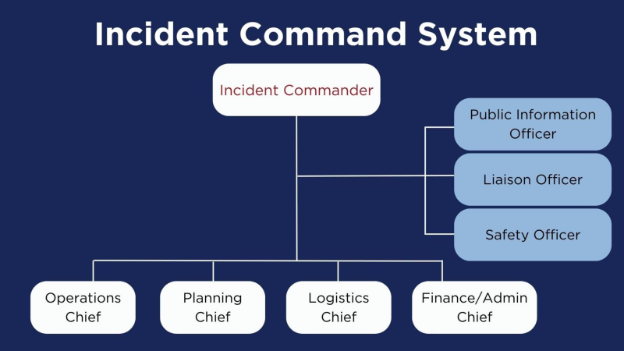Disaster Medicine Handbook: A Quick Reference
Incident Command System (ICS)
In a disaster, many groups may need to work together: fire departments, hospitals, government agencies, and more. Most disasters start at a local level. However, limited resources and personnel may require bringing in partners at the community, state, and federal levels. Coordinating multiple agencies in disasters can be challenging. It’s like having too many cooks in the kitchen. Who is in charge? How do we communicate effectively?
 |
We learned a lot of difficult lessons after the terrorist attacks on September 11, 2001. Poor coordination led to delays, confusion, and miscommunication. |
A failure to address these potential issues may result in inefficiency, redundancy, and confusion in deploying resources and personnel.
The Incident Command System (ICS) is a flexible and scalable framework that can be used in any scale of disaster planning, response, and recovery.

5 Main Functions of ICS
- Incident Command
- Operations
- Planning
- Logistics
- Finance/Administration
Within Incident Command, additional staff can be added that includes a public information officer, liaison officer and safety officer.
|
Incident Command |
|
| Operations Section | Plans and performs activities towards accomplishing objectives |
| Planning Section | Collects, evaluates, and processes data about the situation and resources; disseminates this information |
| Logistics Section | Provides support that can include facilities, transportation, communication, supplies, food |
| Finance/Administration Section | Track, analyze, and estimate costs; identify cost-saving actions |
14 Main Features of ICS
| Common Terminology | Common terms around functions/functional units, resources, and facilities |
| Modular Organization | The structure expands based on the size, complexity, and hazards of the disaster |
| Management by Objectives |
Creates specific and measurable objectives Identifies actions and tasks that achieve those objectives Develops plans/procedures/protocols Tracks results |
| Incident Action Plan | Clear and concise communication of objectives that guides activities |
| Manageable Span of Control |
Ensure efficiency and effectiveness Management can communicate with and supervise all assets |
| Incident Facilities and Locations |
Key places include:
|
| Comprehensive Resource Management |
Tracks:
|
| Integrated Communication | A plan for how everyone communicates across agencies. |
| Establishment and Transfer of Command |
The command function should be clearly established at the beginning of an incident. The jurisdiction or organization with primary responsibility for the incident designates the Incident Commander and the process for transferring command. Transfer of command may occur during the course of an incident. When command is transferred, the process should include a briefing that captures all essential information for continuing safe and effective operations. |
| Unified Command |
Establishes jointly agreed upon objectives in situations where there are multiple overlapping authorities or jurisdictions involved. |
| Chain of Command/Unity of Command | Individuals report to one person. Note: it does not prevent informal communication and information sharing with other sections. |
| Accountability | Account for all response resources, including personnel, and adherence to all other ICS principles such as following the Incident Action Plan. |
| Deployment/Dispatch | Resource deployment when requested by authorities. |
| Information/Intelligence Management | Information gathered and shared through chain of command, including Essential Elements of Information (EEI). |
 |
Has ICS ever be activated in your organization? What is your role and responsibility in the Incident Command System? |
Resources:
Written by Dennis Ren
Last updated: 11/10/2025